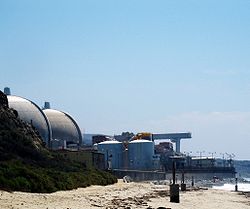Edison bailed out CA Cap & Trade auction
by CalWatchdog Staff | January 9, 2013 1:14 pm
 [1]Jan. 9, 2013
[1]Jan. 9, 2013
By Wayne Lusvardi
The facts slowing coming out about the state’s first Cap and Trade auction seriously question whether the system is already being gamed by government, together with electric utilities.
Edison International[2] made an announcement on Dec. 20, 2012: At California’s first Cap and Trade auction held back on Nov. 14, 2012, it offered to buy 21 times more pollution permits than allowed.
Edison’s overbidding error ended up amounting to 72 percent of all the bid offers and bailed out the Cap and Trade auction from failure. About a month later, Edison’s unregulated power-generating subsidiary company, Mission Energy, declared bankruptcy on Dec. 17, 2012.
CARB’s “Credibility called into question”
Bloomberg.com[3] reported on Dec. 20, 2012 that Edison International “unintentionally” bid for twice as many pollution allowance permits as were offered for sale. Edison said its error was due to submitting a bid in the wrong format. For anyone who has ever worked in a large bureaucratic utility, Edison’s statement seems unbelievable. The number of hands it would typically take to review and sign off on any bid would have made highly suspicious any so-called bidding error resulting in 21 times the permits offered. Moreover, CARB provided training on auction procedures and held a test sale back on Aug. 30.
Bloomberg New Energy Finance analyst William Nelson said of the California Air Resources Board, “This revelation calls the agency’s credibility into question. For So Cal Ed, it appears now to have 1.61 million allowances it never intended to buy on its hands for which it spent approximately $16 million. The irony is that Edison was ultimately rewarded for its mistake, procuring credits at a price that is ‘in the money,’ today.”
Edison bid for approximately 16,632,000 pollution permits out of the total of 23.1 million permits allowed. After CARB disqualified Edison’s excessive bid, Edison ended up buying 4.05 million pollution permits. This was still 1.61 million more permits than its allowance of permits
CARB Chair Mary Nichols declared the auction “went without a hitch” and was “vibrant and successful.” However, Nichols failed to mention at that time that, without Edison’s “error,” the auction would have been a failure. She also waited until Christmas week when the public’s attention was preoccupied to release information about Edison’s bidding error.
Nichols’ claimed CARB created a “vibrant market” for pollution permits. But the auction conducted last November was not a market auction. This was because there was no competitive bidding, even with Edison’s excess demand for permits. Instead, bid prices for nearly all 23.1 million permits went for the minimum bid of $10 per ton of pollution, or a few cents more in some cases. Bidders merely paid a disguised tax and went back to business without reducing any emissions.
Edison arm declares bankruptcy
Coincidentally, on Dec. 17, 2012, Edison’s subsidiary, Mission Energy, filed for bankruptcy[4]. Mission Energy listed $5.13 billion in assets and $5.09 billion in liabilities. Since both companies are separate legal entities, Edison International apparently did not dump the cost of its trading error onto insolvent Mission Energy. However, the law firm of Pillsbury, Winthrop, Shaw and Pittman, LLP[5] in New York, representing creditor Chevron, did not respond to an inquiry whether the bankruptcy judge could “puncture the corporate veil” and void Edison International’s CARB auction bid.
Mission Energy was created during the California Energy Crisis of 2000-01 in a “ring fencing”[6] strategy to absorb financial losses of its parent company, Edison International. Ring fencing is a way to fence off certain assets or liabilities by creating a new subsidiary. By ring fencing a parent company can protect itself against bankruptcy.
Bid rigging and plausible collusion
This seriously calls into question whether either collusion or gaming of the bid system took place. Back on May 18, 2012[7], this writer warned that CARB’s auction system created perverse incentives for government to game or collude with electric utilities to generate more tax revenues for the state. Edison’s apparent auction bidding strategy was to bid for excessive permits to prevent the auction from being declared a failure and buy up all the permit allowances. Edison’s initial bid for 72 percent of the permits was then negotiated downward after the auction to almost exactly the same number of permits allowed.
The effect that this apparent overbidding scheme may have on the California Chamber of Commerce’s lawsuit[8] charging CARB with profiting from Cap and Trade auctions remains to be seen.
- [Image]: http://www.calwatchdog.com/2011/03/12/end-of-nuke-power-in-ca/san_onofre_nuclear-plant/
- Edison International: http://www.bloomberg.com/news/2012-12-20/edison-snafu-skews-demand-in-first-california-carbon-permit-sale.html
- Bloomberg.com: http://www.bloomberg.com/news/2012-12-20/edison-snafu-skews-demand-in-first-california-carbon-permit-sale.html
- bankruptcy: http://www.latimes.com/business/la-fiw-edison-international-unit-files-for-bankruptcy-protection-20121217,0,2084883.story
- Pillsbury, Winthrop, Shaw and Pittman, LLP: http://www.edisonmissionrestructuring.com/pdflib/158_49219.pdf
- “ring fencing”: http://www.cfo.com/article.cfm/3001311/2/c_2984343
- May 18, 2012: http://www.calwatchdog.com/2012/05/18/will-cap-and-trade-cure-californias-deficit/
- California Chamber of Commerce’s lawsuit: http://calwatchdog.com/1012/11/16/cal-chamber-sues-state-for-profiting-from-ab32/
Source URL: https://calwatchdog.com/2013/01/09/edison-bailed-out-ca-cap-trade-auction/